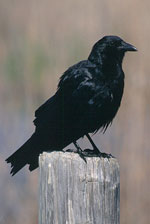Mortality Threats to Birds - West Nile Virus (Flavivirus)
West Nile virus (WNV) was first isolated in 1937 and it was known to infect people in Africa, West Asia, and the Middle East. It was not identified in the Western Hemisphere until 1999 in New York City when it caused a large die off of American Crows. Since then, despite spraying insecticides to kill adult and larval mosquitoes which transmit the virus, WNV has spread rapidly across the U.S. As of January 2005, WNV has been identified in all states except HI, AK, and WA. It also occurs in 7 Canadian provinces, Puerto Rico, Mexico, and some Caribbean islands. WNV is transmitted to humans through mosquito bites. Mosquitoes become infected when they feed on infected birds that have high blood levels of WNV. Wild birds are the major reservoir of the virus. WNV has been detected in at least 48 species of mosquitoes and in at least 18 species of mammals, including humans.
Symptoms
Symptoms range from none to severe neurologic illness, including weakness, stumbling, trembling, head tremors, inability to fly or walk, and lack of awareness such that sick birds can be picked up.
Birds Affected
WNV has been identified in over 250 species of birds in the U.S. American Crow, Fish Crow, and Blue Jays are especially susceptible, however, the total mortality and impact on specific bird populations is unknown. Some birds show signs of becoming resistant to the disease. WNV is of special concern for endangered and threatened birds.
Control
In agricultural and residential areas, empty anything that contains standing water to prevent mosquitoes from breeding. Change the water in birdbaths often. Spraying insecticides to kill larvae is the only recommended pesticide application.
Further Information
in 2001, ABC to help fund research into a vaccine for West Nile virus to use on endangered species. The DNA-based vaccine was developed at the Centers for Disease Control and Prevention laboratory in Atlanta, with additional support from the American Zoo and Aquarium Association and the Disney Wildlife Conservation Fund. Lab tests were so successful that the entire captive California Condor population at the Los Angeles and San Diego Zoos and the Peregrine Fund's World Center for Birds of Prey were vaccinated, beginning in 2002. To date, no condor that has been vaccinated has died as a result of West Nile, contributing significantly to the remarkable recovery of the species.
ABC's Policy Statement on West Nile Virus |
